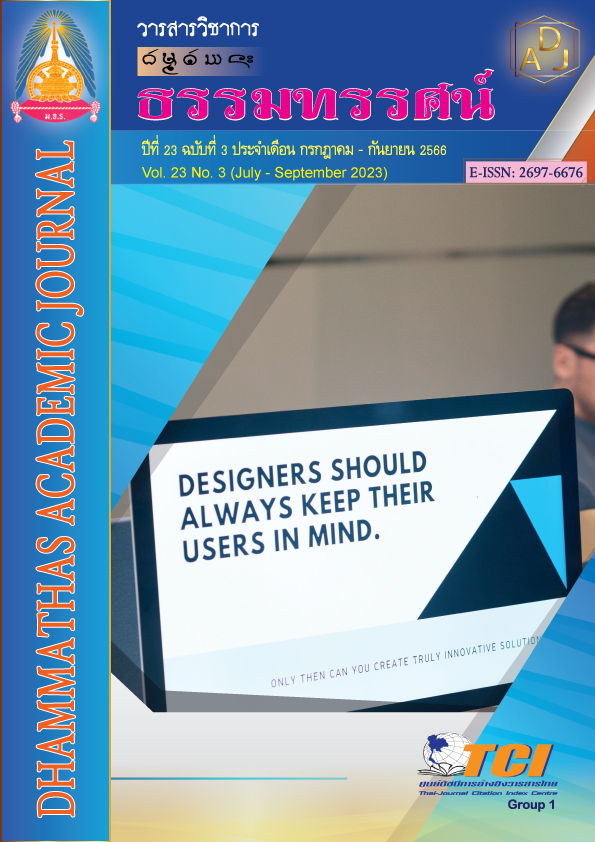Lang Man behind the Scenes: Patriarchy in a Yaoi Novel
Main Article Content
Abstract
This research examines the Yaoi novel Lang Man Behind the Scenes for: 1) uses of patriarchal power and 2) evidence of defiance against patriarchal power. The research is designed as a qualitative research. The study applied Kate Millett’s conceptual framework on patriarchy.
The results were as follow:
1. Patriarchal power and defiance against it could be characterized in four different contexts: 1) the use of father's authority in the family between father and child; 2) in university and work settings based on seniority, among friend groups, and between supervisors and subordinates; 3) between the male protagonists; and 4) between male and female characters.
2. The novel showed evidence of defiance against patriarchal power in all four of the aforementioned contexts. 1) Defiance against uses of patriarchal power in the family occurres between the father and child and between the father and mother. 2) Defiance against uses of patriarchal power in the university and work setting occurs within both the seniority and the supervisor-subordinate systems. The novel also portrays defiance against uses of patriarchal power 3) between the male protagonists and 4) between male and female characters.
Article Details

This work is licensed under a Creative Commons Attribution-NonCommercial-NoDerivatives 4.0 International License.
เพื่อให้เป็นไปตามกฎหมายลิขสิทธิ์ ผู้นิพนธ์ทุกท่านต้องลงลายมือชื่อในแบบฟอร์มใบมอบลิขสิทธิ์บทความ ให้แก่วารสารฯ พร้อมกับบทความต้นฉบับที่ได้แก้ไขครั้งสุดท้าย นอกจากนี้ ผู้นิพนธ์ทุกท่านต้องยืนยันว่าบทความ ต้นฉบับที่ส่งมาตีพิมพ์นั้น ได้ส่งมาตีพิมพ์เฉพาะในวารสาร วิชาการธรรม ทรรศน์ เพียงแห่งเดียวเท่านั้น หากมีการใช้ ภาพหรือตารางของผู้นิพนธ์อื่นที่ปรากฏในสิ่งตีพิมพ์อื่นมาแล้ว ผู้นิพนธ์ต้องขออนุญาตเจ้าของลิขสิทธิ์ก่อน พร้อมทั้ง แสดงหนังสือที่ได้รับการยินยอมต่อบรรณาธิการ ก่อนที่บทความจะได้รับการตีพิมพ์References
ณิชชารีย์ เลิศวิชญโรจน์. (2560). หัวใจ/วาย. กรุงเทพฯ: บันบุ๊คส์.
นัทธนัย ประสานนาม. (2562). นวนิยายยาโออิของไทย: การศึกษาเชิงวิเคราะห์. วารสารวิชาการหอสมุดแห่งชาติ, 7(2), 15-34.
_______. (2563). การเว้นระยะห่างทางเพศสถานะ: นวนิยายยาโออิของไทยในการเมืองเรื่องขนบวรรณกรรมกับการตีความ. วารสารศาสตร์, 13(3), 160-187.
รื่นฤทัย สัจจพันธุ์. (2560). อ่านวรรณกรรม GEN Z. กรุงเทพฯ: แสงดาว.
เสนาะ เจริญพร. (2548). ผู้หญิงกับสังคมในวรรณกรรมไทยยุคฟองสบู่. กรุงเทพฯ: มติชน.
ศิริสุกาญจน์ สุจริตพิทักษ์กุล. (2562). อัตลักษณ์และพื้นที่ทางสังคมของกลุ่มชายรักชายในละครชุดที่เผยแพร่ระหว่าง พ.ศ. 2557-2560. (วิทยานิพนธ์ศิลปศาสตรมหาบัณฑิต). ขอนแก่น: มหาวิทยาลัยขอนแก่น.
อนุชา พิมศักดิ์ และโสภี อุ่นทะยา. (2564). อุปลักษณ์สัตว์ที่แสดงมโนทัศน์เกี่ยวกับตัวละครพระเอกและนายเอกในนวนิยายวัยรุ่นแนววาย. วารสารมนุษยศาสตร์และสังคมศาสตร์ มหาวิทยาลัยนครพนม, 11, 304-316.
อรทัย เพียยุระ. (2564). วรรณกรรมกับเพศภาวะ. (พิมพ์ครั้งที่ 3). ขอนแก่น: ขอนแก่นการพิมพ์.
อรสุธี ชัยทองศรี. (2560). Boys Love Manga and Beyond: History, Culture, and Community in Japan. วารสารมนุษยศาสตร์วิชาการ คณะมนุษยศาสตร์ มหาวิทยาลัยเกษตรศาสตร์, 24(2), 344-359.
Afterday และ west. (2564). หลังม่าน Behind the scenes (ฉบับปรับปรุงเนื้อหา). (พิมพ์ครั้งที่ 2). กรุงเทพฯ: เอเวอร์วาย.
Whitehead, S. (2010). Men and Masculinities. Cambridge: Polity Press.

